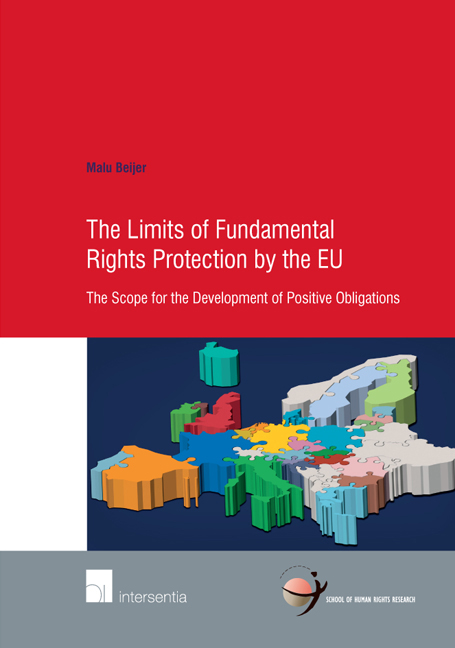 Limits of Fundamental Rights Protection by the EU
Limits of Fundamental Rights Protection by the EU Book contents
- Frontmatter
- About the Author
- Acknowledgements
- Contents
- Abbreviations
- Table of Cases
- Chapter 1 Introduction
- PART I THE CONCEPT OF POSITIVE OBLIGATIONS WITHIN THE CONTEXT OF THE EUROPEAN CONVENTION ON HUMAN RIGHTS
- PART II THE SCOPE FOR THE DEVELOPMENT OF POSITIVE OBLIGATIONS WITHIN THE CONTEXT OF EU LAW – AN ANALYSIS OF THE SPECIFIC PARAMETERS OF THE EU LEGAL ORDER AND THE EU SYSTEM OF FUNDAMENTAL RIGHTS PROTECTION
- Chapter 6 Main Principles of the EU System of Fundamental Rights Protection
- Chapter 7 The Institutional Characteristics and Judicial Culture of the ECJ
- Chapter 8 EU Competences and Subsidiarity in Fundamental Rights Protection
- Chapter 9 The Limited Scope of Application of EU Fundamental Rights
- Chapter 10 Part II – Conclusions
- PART III SYNTHESIS
- Bibliography
- Index
- Miscellaneous Endmatter
Chapter 7 - The Institutional Characteristics and Judicial Culture of the ECJ
from PART II - THE SCOPE FOR THE DEVELOPMENT OF POSITIVE OBLIGATIONS WITHIN THE CONTEXT OF EU LAW – AN ANALYSIS OF THE SPECIFIC PARAMETERS OF THE EU LEGAL ORDER AND THE EU SYSTEM OF FUNDAMENTAL RIGHTS PROTECTION
Published online by Cambridge University Press: 27 September 2018
- Frontmatter
- About the Author
- Acknowledgements
- Contents
- Abbreviations
- Table of Cases
- Chapter 1 Introduction
- PART I THE CONCEPT OF POSITIVE OBLIGATIONS WITHIN THE CONTEXT OF THE EUROPEAN CONVENTION ON HUMAN RIGHTS
- PART II THE SCOPE FOR THE DEVELOPMENT OF POSITIVE OBLIGATIONS WITHIN THE CONTEXT OF EU LAW – AN ANALYSIS OF THE SPECIFIC PARAMETERS OF THE EU LEGAL ORDER AND THE EU SYSTEM OF FUNDAMENTAL RIGHTS PROTECTION
- Chapter 6 Main Principles of the EU System of Fundamental Rights Protection
- Chapter 7 The Institutional Characteristics and Judicial Culture of the ECJ
- Chapter 8 EU Competences and Subsidiarity in Fundamental Rights Protection
- Chapter 9 The Limited Scope of Application of EU Fundamental Rights
- Chapter 10 Part II – Conclusions
- PART III SYNTHESIS
- Bibliography
- Index
- Miscellaneous Endmatter
Summary
INTRODUCTION
This chapter will explore further to what extent a development of positive obligations by the ECJ can be expected on the basis of its institutional position and its particular judicial culture. The ECJ has quite a different institutional position compared to the ECtHR, at least in some respects, and it also has a rather different judicial culture. There is a great complexity of factors which the ECJ must take into account and different ‘ audiences ‘ to which the ECJ must listen that can pull it in different directions. These factors can have an impact on the potential for a development of positive obligations by this particular court.
This chapter starts offby discussing two specific judgments of the ECJ (section 7.2.). In one of these judgments, the ECJ decided not to recognise a positive obligation to protect a fundamental right (the case of Bostock); while in the other case, it did impose a positive obligation on the member states (the case of Chatzi). Both of these cases have been heavily criticised. It has been held that the ECJ did too little in the first case and too much in the second case. These are two types of criticism the ECJ may easily incur. The aim of this chapter is to place such judgments in the perspective of the different roles and judicial styles that the ECJ may adopt, and to examine whether and how the ECJ could respond to the arguments of its critics. Aft er discussing the judgments of the ECJ in the cases of Bostock and Chatzi, and the criticism which these judgments have incurred, various specific factors relating to the judicial style as well as the institutional position of the ECJ are discussed that could explain its approach in these, as well as other judgments. These factors include the role and judicial style of the ECJ in general (section 7.3.); the procedures that are used to bring fundamental rights cases before the ECJ (section 7.4.); the institutional position of the ECJ vis- a -vis the EU institutions and the member states (section 7.5.); as well as the specific role played by the EU and the ECJ in the field of fundamental rights (section 7.6.).
- Type
- Chapter
- Information
- Limits of Fundamental Rights Protection by the EUThe Scope for the Development of Positive Obligations, pp. 137 - 178Publisher: IntersentiaPrint publication year: 2017
